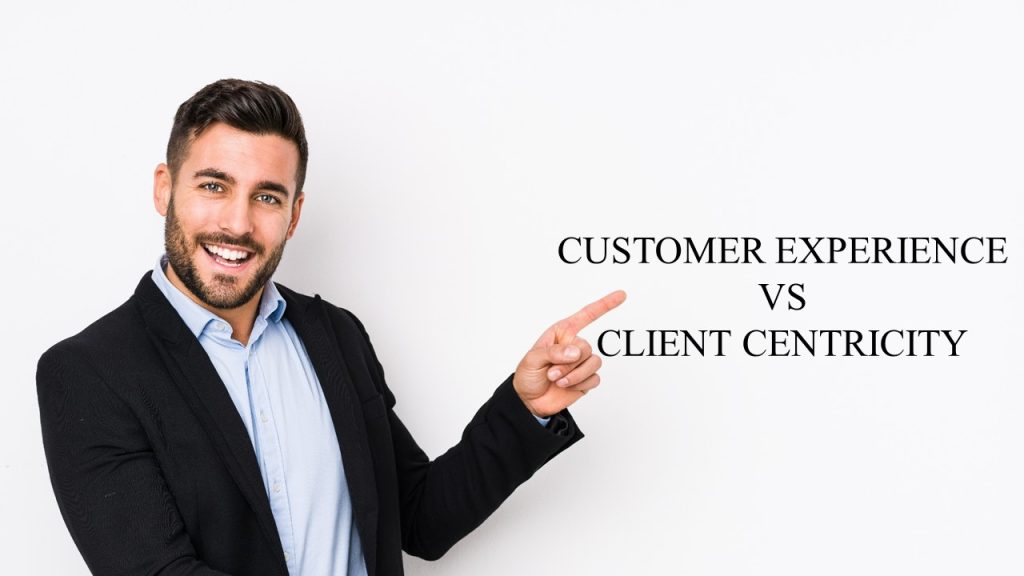
Customer experience (CX) and client centricity are related concepts, but they are not the same thing.
Customer experience (CX) refers to the overall perception that a customer has of a company, based on their interactions with it. It includes all touchpoints, such as the website, customer service, and in-store experience, and it covers the entire customer journey, from awareness to post-purchase. CX is a holistic approach to understand, design and measure the customer journey, and make improvements that increase customer satisfaction and loyalty.
Client centricity, on the other hand, is a business strategy that prioritizes the needs and preferences of the customer. It is a way of thinking and acting that puts the client’s needs at the center of all business decisions. It is about understanding the customer’s needs and tailoring products, services, and interactions to meet those needs. It is a way of creating value for the customer, and it is a long-term approach to build trust and loyalty.
In summary, CX is focused on measuring and improving the customer’s overall perception of the company, while client centricity is focused on understanding and addressing the specific needs of individual customers. Both concepts are important, but they have different focuses and goals. A company that wants to provide a great customer experience should also have a client centric mindset.
Free Download
Download your copy of a research report on B2B customer experience practices in India.
Our research is to understand the best practices amongst the enterprises across various sectors in Indian region when it comes to Customer Experience Transformation. Customer Experience as a concept is generally not given the required attention is B2B sector. With increase in the competition in the market, customer experience is one of the major thing which defines the performance of the organization.

Example 1
A company that sells high-end kitchen appliances. This company has a customer experience strategy in place that focuses on creating a seamless and enjoyable shopping experience for customers. They have a user-friendly website, a knowledgeable customer service team, and a well-designed showroom. Customers are greeted warmly upon entering the store, and the sales associates are trained to ask the right questions and guide customers through the purchasing process. Overall, the customer experience at this company is positive and customers feel well-informed and satisfied with their purchase.
The same company also has a client centric approach. They conduct market research and segment their customer base, understanding the different needs and preferences of their target market. This allows them to tailor their products, services, and interactions to the specific needs of different customer segments. For example, they offer a wide range of products for professional chefs, as well as for home cooks, and they have different sales associates to help customers from different segments. They also conduct surveys and collect feedback from customers, to understand their specific needs and preferences and make adjustments to their products and services accordingly.
In this example, the company’s customer experience strategy focuses on creating a positive overall perception of the company, while their client centric approach focuses on understanding and addressing the specific needs of individual customers. Both strategies work together to create a positive shopping experience and increase customer satisfaction and loyalty.
Example 2
A company that sells enterprise software to help with supply chain management. They’ve got a customer experience strategy that makes sure buying from them is a breeze. They’ve got a website that’s easy to navigate, a sales team that’s quick to respond, and an onboarding process that’s as smooth as butter. As a result, their clients are happy with their purchase experience.
But this company doesn’t just stop there, they also have a client-centric approach. They take the time to understand their clients and their specific needs. They research their clients, segment them and tailor their software, services and interactions to specific client segments. For example, they might have different software packages for different industries, and different sales teams to help different client segments. They also ask for feedback and use it to improve their software and services.
In this example, this company’s customer experience strategy is all about making sure their clients have a good overall experience with the company, while their client-centric approach is all about understanding and addressing the specific needs of individual clients. Both strategies work together to create a positive purchasing experience and keep their clients happy.
#nilakantasrinivasan-j #canopus-business-management-group #B2B-client-centric-growth #customer-experience #client-centricity

Client centric strategies play a crucial role in a go-to-market (GTM) strategy, as they help to ensure that the products or services being offered meet the needs and preferences of the target customers. A client-centric approach to GTM focuses on understanding and addressing the unique needs of different segments of customers, rather than treating all customers the same.
Here are a few ways in which a client-centric strategy can be incorporated into a GTM plan:
- Segmentation: Segmenting your target market based on characteristics such as demographics, behavior, and needs can help you to tailor your products and services to specific customer segments. This can result in more effective and efficient marketing efforts.
- Personalization: Personalizing your marketing and sales efforts based on the unique needs and preferences of individual customers can help to build stronger relationships and increase customer loyalty.
- Feedback: Incorporating feedback from customers into your GTM strategy can help you to identify areas for improvement and adapt your approach as needed.
- Empathy: Putting yourself in the customer’s shoes and trying to understand their needs, pain points and preferences can help you to create products and services that better meet their needs.
- Continuous improvement: Continuously monitoring and analyzing customer feedback and market trends to make adjustments to your GTM strategy as needed.
By taking a client-centric approach to GTM, companies can improve their chances of success by creating products and services that are more closely aligned with the needs and preferences of their target customers. This can lead to increased customer loyalty, higher sales, and better overall business performance.
Free Download
Download free XL based touchpoint assessment check sheet for evaluation & benchmarking with instructions
This is an XL based check sheet with two different scenarios – (1) To assess various touchpoints across customer journey and (2) To benchmark touchpoints against competition for similar journey steps.

#nilakantasrinivasan-j #canopus-business-management-group #B2B-client-centric-growth #client-centric-strategy

A Go-To-Market strategy is a plan for how you will bring your products or services to market and reach your target customers. It includes elements such as product positioning, target market, distribution channels, sales and marketing tactics, and key performance indicators.
A good GTM can directly improve the chances of the overall company’s business growth rate.
Here are some steps you can take to create a GTM strategy for your company:
- Understand your target market: It’s essential to have a clear understanding of your target customers, including their needs, pain points, and buying habits. This information can help you to identify the most effective ways to reach and engage with them.
- Define your product positioning: This is how you want your product or service to be perceived by your target customers. It should be based on your understanding of your target market and should take into account your competitive landscape.
- Identify distribution channels: Determine which channels will be most effective for reaching your target customers. This could include online and offline channels, such as e-commerce, retail stores, and direct sales.
- Develop a sales and marketing plan: Once you have a clear understanding of your target market, product positioning, and distribution channels, you can develop a sales and marketing plan that includes tactics such as advertising, public relations, content marketing, and events.
- Set key performance indicators (KPIs): These are metrics that you can use to measure the success of your GTM strategy. Examples of KPIs could include website traffic, number of leads generated, sales, and customer retention.
- Continuously Monitor and Optimize: Once your GTM strategy is in place, it’s important to continuously monitor and optimize it based on the data and feedback you receive. This will help you to adapt to changes in your market and customer needs and fine-tune your approach.
It’s worth noting that creating a GTM strategy is an iterative process. You may need to adjust and refine your strategy as you learn more about your target market and customers, or as the market changes. And also, these steps are general guidelines and the actual steps you need to take might be different based on the specific situation of your company.
#nilakantasrinivasan-j #canopus-business-management-group #B2B-client-centric-growth #Business-growth

Improving EBITDA can be a tricky business for B2B companies. There are a lot of factors that come into play, and it’s not always clear what the root of the problem is.
For example, if sales aren’t where they should be, it could be because the company isn’t reaching the right market or because their sales team isn’t as effective as it could be. On the other hand, if the product or service isn’t selling well, it could be that it’s not meeting customer needs or it’s not priced competitively.
Marketing is another area where things can get tricky. A lack of effective marketing can lead to low brand awareness and a lack of leads, which can impact sales. And if the company is not differentiating its products and services from competitors, then it will be hard for them to stand out in the market.
Operations can also play a big role in EBITDA. A lot of B2B companies struggle with high overhead costs and inefficiencies in their processes. This can include things like lack of automation, lack of process standardization, and a lack of focus on cost-cutting.
And let’s not forget about finances and funding. A lot of B2B companies struggle with understanding their finances and managing their finances effectively. And if a company doesn’t have access to adequate funding, it can be hard for them to invest in areas that could improve their EBITDA.
All of these factors can make it difficult for B2B companies to improve EBITDA, but by identifying the root cause of the problem and taking a strategic approach, they can make the improvements they need to see better EBITDA and overall growth
#nilakantasrinivasan-j #canopus-business-management-group #B2B-client-centric-growth

Metrics and OKRs serve different purposes and complement each other in various ways.
Metrics are specific, measurable values that help organizations track their performance and progress towards specific goals. Metrics are typically used to evaluate performance and make data-driven decisions. They provide a clear understanding of what is being measured and how progress is being made.
OKRs (Objectives and Key Results), on the other hand, are a goal-setting framework that provides a clear and specific structure for setting and tracking goals. OKRs help organizations align their efforts towards achieving specific and measurable objectives, and provide a clear understanding of what success looks like and how it will be achieved.
When used together, metrics and OKRs can provide a powerful toolkit for driving performance and growth. Metrics provide a clear understanding of what is being measured and how progress is being made, while OKRs provide a clear structure for setting and tracking goals. This can help organizations make data-driven decisions and align their efforts towards achieving specific and measurable objectives.
In summary, even if a company has a strong metrics culture, OKRs can still provide significant value by providing a clear structure for setting and tracking goals and aligning efforts towards achieving specific and measurable objectives.
#nilakantasrinivasan-j #canopus-business-management-group #B2B-client-centric-growth #OKR

Grading in OKRs refers to the process of evaluating the progress made towards achieving the objectives and key results set in the OKRs. The grading process helps to determine the level of success achieved and provides feedback on areas that need improvement.
Here’s how to grade OKRs:
- Frequency: OKRs should be graded regularly, typically at the end of each quarter or half-year. This helps ensure that progress is being monitored regularly and that any necessary adjustments can be made in a timely manner.
- Who should grade: OKRs can be graded by the individuals who set the objectives, their managers, or a designated team within the organization. It is important to ensure that the grading is done objectively and consistently across the organization.
- Criteria: The criteria for grading OKRs should be based on the specific objectives and key results set in the OKRs. For example, if the objective is to increase sales by a certain percentage, the criteria for grading might be the actual sales figures achieved.
In general, OKRs are graded on a scale of 0-1, with 0.0 indicating no progress and 1.0 indicating full attainment of the objective. Grading provides a clear picture of progress and allows individuals and teams to focus on the areas where they need to improve.
It is important to note that the grading process should be a supportive and constructive feedback mechanism, rather than a source of stress or negativity. The focus should be on learning and continuous improvement, rather than on assigning blame or punishment for not achieving objectives.
OKRs can be graded at different frequencies, depending on the nature of the objectives and the goals of the organization. Here are two common approaches to grading OKRs:
End of cycle grading: OKRs are graded at the end of each quarter or half-year, after the set timeframe for achieving the objectives has passed. This approach is suitable for objectives that are long-term or have a significant impact on the organization and its operations.
Weekly or monthly grading: OKRs are graded on a regular basis, such as every week or every month. This approach is suitable for objectives that are more short-term or have a smaller impact on the organization. This approach provides more frequent feedback and allows individuals and teams to adjust their focus and priorities on an ongoing basis.
Ultimately, the frequency of grading should be determined by the nature of the objectives and the goals of the organization. Both end of cycle and frequent grading have their benefits, and the approach that is chosen should align with the overall strategy and goals of the organization.
Grading OKRs too often can lead to several problems, including:
- Over-emphasis on short-term results: Frequent grading can create a focus on short-term results, rather than on long-term goals and objectives. This can lead to a reduction in the strategic focus of individuals and teams and a lack of commitment to achieving meaningful and impactful results.
- Increased stress and pressure: Grading OKRs too frequently can increase stress and pressure on employees, especially if the grading process is overly punitive or negative. This can lead to decreased motivation and engagement, and may even lead to burnout or high turnover rates.
- Decreased creativity and innovation: If grading OKRs is done in a rigid and prescriptive manner, it can stifle creativity and innovation. Individuals and teams may be reluctant to take risks and try new approaches if they are constantly being judged and evaluated.
- Reduced focus on learning and continuous improvement: If grading OKRs is done in a way that emphasizes fault-finding and punishment, rather than learning and continuous improvement, it can reduce the focus on growth and development. This can lead to a lack of progress and an inability to adapt to changing conditions and requirements.
In general, it is important to ensure that the grading process is supportive, constructive, and focused on continuous improvement, rather than on punishment or blame. This can be achieved by setting clear criteria for grading, involving employees in the grading process, and providing regular feedback and coaching to help individuals and teams achieve their goals
#nilakantasrinivasan-j #canopus-business-management-group #B2B-client-centric-growth #OKR

There is a strong linkage between a company’s vision and strategy and their OKRs. OKRs (Objectives and Key Results) are a tool used to align and drive progress towards a company’s overall vision and strategy.
Here’s how to create the linkage between a company’s vision and strategy and their OKRs:
- Start with the vision and strategy: Clearly define the company’s vision and overall strategy, including the goals and objectives that support the vision and strategy.
- Align OKRs with vision and strategy: Ensure that the objectives and key results of each team and individual are aligned with the company’s overall vision and strategy. This helps ensure that everyone is working towards a common goal and that progress is being made towards the overall vision and strategy.
- Communicate the linkage: Clearly communicate the linkage between the company’s vision and strategy and the OKRs to all stakeholders, including employees, managers, and executives. This helps ensure everyone is aware of the overall goals and objectives and understands how their work contributes to the vision and strategy.
- Regularly review and adjust: Regularly review and adjust the OKRs to ensure they are aligned with the company’s vision and strategy. This helps keep the focus on the most important goals and objectives and ensures progress is being made towards the overall vision and strategy.
By creating a clear linkage between a company’s vision and strategy and their OKRs, organizations can ensure that everyone is working towards the same goals and that progress is being made towards achieving the overall vision and strategy.
Google has a company purpose of “to organize the world’s information and make it universally accessible and useful.” This purpose serves as the guiding principle for the company and informs their overall strategy.
Google’s OKRs are aligned with this purpose and focus on improving their products and services to better serve their customers. For example, one of their OKRs might be “Improve search results relevance by X% within the next quarter.” This objective is aligned with their company purpose of making information accessible and useful, and the key result (improvement in search results relevance) helps measure progress towards that goal.
Another example might be “Expand Google Maps coverage to X new countries within the next year.” This objective aligns with the company purpose of organizing information, and the key result (expansion of coverage to new countries) helps measure progress towards that goal.
By aligning their OKRs with their company purpose, Google is able to focus on the most important goals and objectives and ensure that everyone is working towards the same vision. This helps drive progress towards achieving their company purpose and ensures that their products and services continue to improve and meet the needs of their customers.
#nilakantasrinivasan-j #canopus-business-management-group #B2B-client-centric-growth #OKR

Here’s a general roadmap for implementing OKRs (Objectives and Key Results) across an organization:
- Awareness and education: Start by raising awareness and educating all stakeholders, including employees, managers, and executives, about OKRs, their benefits, and how they will be used in the organization.
- Define the OKR process: Define the process for setting, tracking, and achieving OKRs, including who will be responsible for setting and tracking OKRs, how often they will be reviewed, and how progress will be communicated.
- Define OKRs for teams: Work with teams to define their objectives and key results. Encourage teams to set ambitious, but realistic, goals that align with the organization’s overall strategy.
- Pilot phase: Launch a pilot phase with a select group of teams to test the process and make any necessary adjustments. This phase should provide feedback to refine the OKR process for the organization.
- Roll out OKRs to the rest of the organization: Based on the results of the pilot phase, roll out the OKR process to the rest of the organization. Provide ongoing support and training to help teams get started and ensure they are effectively using OKRs.
- Monitor progress and adjust: Regularly monitor progress and adjust the OKR process as needed to ensure it is effective and efficient. Celebrate successes and learn from failures to continuously improve the OKR process.
- Make OKRs a habit: Make OKRs a habit in the organization by regularly setting and tracking progress, celebrating achievements, and encouraging teams to continuously improve.
This roadmap should provide a general framework for implementing OKRs, but the specific timeline, approach, and details will vary depending on the size and complexity of the organization and the specific goals and objectives of the OKR implementation.
#nilakantasrinivasan-j #canopus-business-management-group #B2B-client-centric-growth #OKR

Client centricity plays a crucial role in improving EBITDA for B2B companies. When a company is client-centric, it focuses on understanding and meeting the needs of its customers. This can lead to a number of benefits that can help to improve EBITDA.
Knowing the Client needs : Firstly, by understanding the needs of its customers, a company can create products and services that are tailored to meet those needs. This can lead to increased sales and higher profit margins. Additionally, a company that is client-centric is better able to identify and address any pain points that its customers are experiencing, which can lead to improved customer satisfaction and loyalty.
Communicate & Collaborate : Secondly, when a company is client-centric, it can lead to better communication and collaboration with its customers. This can help to build strong relationships, which can lead to repeat business and positive word-of-mouth recommendations. This can lead to increased sales and improved profit margins.
Agile Mindset : Lastly, when a company is client-centric, it is better able to anticipate and adapt to changes in the market. This can include changes in customer needs, competitor activity, and industry trends. By being able to anticipate and adapt to these changes, a company can be more agile and better positioned to capitalize on new opportunities.
In summary, client centricity plays a vital role in improving EBITDA for B2B companies. It enables companies to create products and services that meet customer needs, build strong relationships, and anticipate and adapt to changes in the market. All of these factors can lead to increased sales, improved profit margins, and overall growth for the company.
#nilakantasrinivasan-j #canopus-business-management-group #B2B-client-centric-growth #OKR

Here are 7 problems and their impact of Poor Client centricity in B2B Sales Teams:
- Lack of trust and credibility: Without a clear understanding of the client’s needs, wants and pain points, it can be difficult for salespeople to build trust and establish credibility with potential customers.
- Difficulty in differentiating products or services: Poor client centricity can make it difficult to effectively communicate the unique value of products or services to potential customers, which can make it more challenging to differentiate and win deals.
- Lack of effective value proposition: Without a clear understanding of the client’s needs, it can be difficult to create an effective value proposition, which can make it challenging to close deals.
- Poor lead qualification: Without proper client centricity, it can be difficult to identify and qualify leads that are most likely to convert into customers.
- Difficulty in retaining customers: Poor client centricity can lead to a lack of understanding of the client’s needs, which can make it more challenging to retain customers over the long-term.
- Difficulty in upselling and cross-selling: Without a clear understanding of the client’s needs, it can be difficult to identify opportunities for upselling and cross-selling, which can limit revenue growth.
- Difficulty in understanding the client’s industry and business environment: Poor client centricity can make it difficult to understand the client’s industry and business environment, which can make it challenging to anticipate and respond to changes in the marketplace.
Free Download
Download your copy of a research report on customer experience trends in India.
There are many trend trackers to present a global perspective of CX, but there aren’t many in India. We have seen that many global trends apply to India, only with subtle difference. This report contains key observations about evolving CX trends in India.

#nilakantasrinivasan-j #canopus-business-management-group #B2B-client-centric-growth #Sales-transformation

B2B companies may find it difficult to improve NPS or client satisfaction for a variety of reasons, including:
- Complex products or services: B2B companies often offer complex products or services that are difficult for customers to understand or use. This can lead to confusion and dissatisfaction among customers.
- Long sales cycles: The B2B sales cycle is often longer than the B2C sales cycle. This can lead to delays in the delivery of products or services and can cause dissatisfaction among customers.
- Lack of personalization: B2B companies often deal with multiple decision-makers and stakeholders within a single organization, which can make it challenging to personalize the customer experience.
- Limited customer interactions: B2B companies may have fewer interactions with customers than B2C companies, which can make it difficult to gather customer feedback and identify areas for improvement.
- Limited resources: B2B companies may have limited resources to devote to customer satisfaction initiatives, such as hiring customer service representatives or investing in customer feedback systems.

Meeting Service Level Agreements (SLAs) in B2B organizations can be difficult for a variety of reasons, including:
- Complex products or services: B2B companies often offer complex products or services that require specialized knowledge or expertise to maintain or repair. This can make it difficult to meet SLAs for repair or maintenance times.
- Long sales cycles: The B2B sales cycle is often longer than the B2C sales cycle. This can lead to delays in the delivery of products or services and can make it difficult to meet SLAs.
- Limited resources: B2B companies may have limited resources to devote to meeting SLAs, such as hiring additional staff or investing in new equipment.
- Lack of standardization: Different customers may have different expectations for service and support, which can make it difficult to standardize SLAs across all customers.
- Dependence on third-party vendors: B2B companies may rely on third-party vendors to provide certain products or services, which can make it difficult to control and meet SLAs.
- Limited visibility: B2B companies may have limited visibility into the performance of their products or services after they are delivered to the customer, which can make it difficult to identify and address issues that are impacting SLA performance.
If your are looking for improving ways to meet your SLAs, please contact us
#nilakantasrinivasan-j #canopus-business-management-group #B2B-client-centric-growth #SLA
Sign-up for collaborat newsletter
